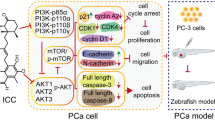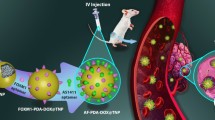Abstract
Background
Penile cancer is a rare malignancy with a poor prognosis, even with various treatment options. Considering the little progress in the study of the pathogenesis and treatment of penile cancer because of the lack of models that mimic the biological properties of the tumor, we have developed a patient-derived xenograft (PDX) model and paired hydrogel-embedded histoculture drug sensitivity test (HDST) to screen for drugs that can inhibit tumors. The increased expression of XPO1, as a key nuclear export protein involved in the transport of various tumor suppressors and cell cycle regulatory proteins, is associated with the prognosis of a variety of tumors [World J Uroly 27(2):141–150, 2009]. Selinexor is an inhibitor of XPO1, which can treat cancers, such as multiple myeloma, gastric cancer, triple-negative breast cancer, and non-small cell carcinoma [Transl Androl Urol 6(5):785–790, 2017; OncoTargets Therapy 13:6405–6416, 2020]. However, whether XPO1 inhibition has a role in penile cancer remains unknown. Therefore, this article used the PDX and HDST models to investigate whether the inhibition of XPO1 has an effect on penile cancer and its underlying mechanism.
Methods
We used penile cancer tumor tissues to construct a PDX model of penile cancer and paired PDXE model and confirmed the consistency of PDX tumor tissues in source patients. Then, we assessed the ability of Selinexor to inhibit penile cancer tissues in vivo using a PDX model and in vitro by HDST. We also examined the potential mechanism of XPO1 action on penile cancer by IHC and TUNEL. Finally, we assessed the safety of the drug treatment by H&E and biochemical blood analysis.
Results
Result showed that the penile cancer PDX model and patient penile cancer tissues were clinically consistent in morphological characteristics and protein expression. In addition, Selinexor could inhibit tumor growth in PDX models and HDST. We found that P53, P21 expression was upregulated; Cyclin D1 expression was downregulated, and apoptosis of tumor cells was increased in the Selinexor-treated PDX model. Moreover, it had no significant effect on liver, kidney, and cardiac function.
Conclusion
The PDX model of penile cancer was a powerful tool for penile cancer research and new drug development. It showed that Selinexor can effectively inhibit penile cancer in vitro and in vivo. In addition, XPO1 may affect P53, P21, and Cyclin D1 expression to regulate the growth and apoptosis of penile carcinoma.







Similar content being viewed by others
Data availability
The data that support the findings of this study are available on request from the corresponding author upon reasonable request.
References
Azizian NG, Li Y (2020) XPO1-dependent nuclear export as a target for cancer therapy. J Hematol Oncol 13(1):61
Bleeker MC, Heideman DA, Snijders PJ, Horenblas S, Dillner J, Meijer CJ (2009) Penile cancer: epidemiology, pathogenesis and prevention. World J Urol 27(2):141–150
Chadha J, Chahoud J, Spiess PE (2022) An update on treatment of penile cancer. Ther Adv Med Oncol 14:7428010
Cho SY, Kang W, Han JY, Min S, Kang J, Lee A, Kwon JY, Lee C, Park H (2016) An integrative approach to precision cancer medicine using patient-derived xenografts. Mol Cells 39(2):77–86
Collins A, Miles GJ, Wood J, MacFarlane M, Pritchard C, Moss E (2020) Patient-derived explants, xenografts and organoids: 3-dimensional patient-relevant pre-clinical models in endometrial cancer. Gynecol Oncol 156(1):251–259
Douglawi A, Masterson TA (2017) Updates on the epidemiology and risk factors for penile cancer. Translat Androl Urol 6(5):785–790
Duffy MJ, Synnott NC, Crown J (2017) Mutant p53 as a target for cancer treatment. Eur J Cancer (Oxford, England: 1990), 83:258–265
Georgakilas AG, Martin OA, Bonner WM (2017) p21: A Two-Faced Genome Guardian. Trends Mol Med 23(4):310–319
Gounder MM, Zer A, Tap WD, Salah S, Dickson MA, Gupta AA, Keohan ML, Loong HH, D’Angelo SP, Baker S, Condy M, Nyquist-Schultz K, Tanner L, Erinjeri JP, Jasmine FH, Friedlander S, Carlson R, Unger TJ, Saint-Martin JR, Rashal T, Ellis J, Kauffman M, Shacham S, Schwartz GK, Abdul Razak AR (2016) Phase IB Study of Selinexor, a first-in-class inhibitor of nuclear export, in patients with advanced refractory bone or soft tissue sarcoma. J Clin Oncol 34(26):3166–3174
Gravina GL, Senapedis W, McCauley D, Baloglu E, Shacham S, Festuccia C (2014) Nucleo-cytoplasmic transport as a therapeutic target of cancer. J Hematol Oncol 7:85
Hidalgo M, Amant F, Biankin AV, Budinská E, Byrne AT, Caldas C, Clarke RB, de Jong S, Jonkers J, Mælandsmo GM, Roman-Roman S, Seoane J, Trusolino L, Villanueva A (2014) Patient-derived xenograft models: an emerging platform for translational cancer research. Cancer Discov 4(9):998–1013
Jung J, Seol HS, Chang S (2018) The generation and application of patient-derived xenograft model for cancer research. Cancer Res Treat 50(1):1–10
Kyrylkova K, Kyryachenko S, Leid M, Kioussi C (2012) Detection of apoptosis by TUNEL assay. Methods Mol Biol (Clifton, N.J.), 887:41–47
Lai Y, Wei X, Lin S, Qin L, Cheng L, Li P (2017) Current status and perspectives of patient-derived xenograft models in cancer research. J Hematol Oncol 10(1):106
Ma Y, Fan M, Dai L, Kang X, Liu Y, Sun Y, Xiong H, Liang Z, Yan W, Chen K (2015) Expression of p63 and CK5/6 in early-stage lung squamous cell carcinoma is not only an early diagnostic indicator but also correlates with a good prognosis. Thoracic Cancer 6(3):288–295
Malandrakis P, Ntanasis-Stathopoulos I, Gavriatopoulou M, Terpos E (2020) Clinical utility of selinexor/dexamethasone in patients with relapsed or refractory multiple myeloma: a review of current evidence and patient selection. OncoTargets Therapy 13:6405–6416
Marretta AL, Di Lorenzo G, Ribera D, Cannella L, von Arx C, Bracigliano A, Clemente O, Tafuto R, Pizzolorusso A, Tafuto S (2021) Selinexor and the selective inhibition of nuclear export: a new perspective on the treatment of sarcomas and other solid and non-solid tumors. Pharmaceutics 13(9):1522
Melino G (2011) p63 is a suppressor of tumorigenesis and metastasis interacting with mutant p53. Cell Death Different 18(9):1487–1499
Nguyen R, Wang H, Sun M, Lee DG, Peng J, Thiele CJ (2022) Combining selinexor with alisertib to target the p53 pathway in neuroblastoma. Neoplasia (New York, N.Y.), 26:100776
Olesen TB, Sand FL, Rasmussen CL, Albieri V, Toft BG, Norrild B, Munk C, Kjær SK (2019) Prevalence of human papillomavirus DNA and p16 in penile cancer and penile intraepithelial neoplasia: a systematic review and meta-analysis. The Lancet Oncol 20(1):145–158
Pabla N, Dong Z (2012) Curtailing side effects in chemotherapy: a tale of PKCδ in cisplatin treatment. Oncotarget 3(1):107–111
Rosen JC, Weiss J, Pham NA, Li Q, Martins-Filho SN, Wang Y, Tsao MS, Moghal N (2021) Antitumor efficacy of XPO1 inhibitor Selinexor in KRAS-mutant lung adenocarcinoma patient-derived xenografts. Translat Oncol 14(10):101179
Seiler R, Thalmann GN, Rotzer D, Perren A, Fleischmann A (2014) CCND1/CyclinD1 status in metastasizing bladder cancer: a prognosticator and predictor of chemotherapeutic response. Modern Pathol 27(1):87–95
Shi J, Li Y, Jia R, Fan X (2020) The fidelity of cancer cells in PDX models: Characteristics, mechanism and clinical significance. Int J Cancer 146(8):2078–2088
Stratton KL, Culkin DJ (2016) A contemporary review of HPV and penile cancer. Oncology (Williston Park, N.Y.), 30(3):245–249
Subhash VV, Yeo MS, Wang L, Tan SH, Wong FY, Thuya WL, Tan WL, Peethala PC, Soe MY, Tan DSP, Padmanabhan N, Baloglu E, Shacham S, Tan P, Koeffler HP, Yong WP (2018) Anti-tumor efficacy of Selinexor (KPT-330) in gastric cancer is dependent on nuclear accumulation of p53 tumor suppressor. Scient Rep 8(1):12248
Thomas A, Vanthoor J, Himmelreich U, Cawthorne C, Deroose CM, Gsell W, Spans L, Rizzotto L, Leucci E, Van Rompuy AS, Muneer A, Albersen M (2020) European reference network for rare urogenital diseases and complex conditions (eUROGEN). Establishment, characterization, and imaging of a first platinum-resistant penile cancer patient-derived xenograft in nude mice: A eUROGEN Project. Eur Uroly 78(2):294–296
Thomas A, Necchi A, Muneer A, Tobias-Machado M, Tran ATH, Van Rompuy AS, Spiess PE, Albersen M (2021) Penile cancer. Nat Rev Dis Prim 7(1):11
Yoshida GJ (2020) Applications of patient-derived tumor xenograft models and tumor organoids. J Hematol Oncol 13(1):4
Acknowledgements
We thank Nanchang Royo Biotechnology for the technical assistance and instrument support of Jiangxi Provincial Key Laboratory of Laboratory Animals.
Funding
This work was provided by the National Natural Science of China (No. 81760284 to Y. H, No. 82060465 to X.L.), the Natural Foundation of Jiangxi Province (No. 20192BCD40003 to Y. H., No. 20212ACB206023 to X. L.), and the Science Foundation of Jiangxi Provincial Education Department (No. GJJ150231 to Y. H.).
Author information
Authors and Affiliations
Contributions
XL and YH conceived of the study. YH, MJ, HH, FL, YY, CH, and FZ performed experiments and analyzed date. XL and YH wrote the manuscript.
Corresponding author
Ethics declarations
Conflict of interest
The authors declare no competing interests.
Ethics statement
All animal studies were approved by the Institutional Animal Care and Use Committee (IACUC) of Nanchang Royo Biotech Co., Ltd. (Permit RYE2022040301). The patient had signed the informed consent form, and the sample collection was approved by the medical ethics committee of the Second Affiliated Hospital of Nanchang University (Permit No. 2021012). Written informed consent was obtained from the individual(s) for the publication of any potentially identifiable images or data included in this article.
Consent for publication
Informed consent was obtained from the patient and his relatives.
Additional information
Publisher's Note
Springer Nature remains neutral with regard to jurisdictional claims in published maps and institutional affiliations.
Rights and permissions
Springer Nature or its licensor (e.g. a society or other partner) holds exclusive rights to this article under a publishing agreement with the author(s) or other rightsholder(s); author self-archiving of the accepted manuscript version of this article is solely governed by the terms of such publishing agreement and applicable law.
About this article
Cite this article
He, Y., Mei, J., Hao, H. et al. Selinexor demonstrates anti-tumor efficacy in paired patient-derived xenograft models and hydrogel-embedded histoculture drug sensitivity test of penile cancer. J Cancer Res Clin Oncol 149, 6931–6941 (2023). https://doi.org/10.1007/s00432-023-04618-0
Received:
Accepted:
Published:
Issue Date:
DOI: https://doi.org/10.1007/s00432-023-04618-0




